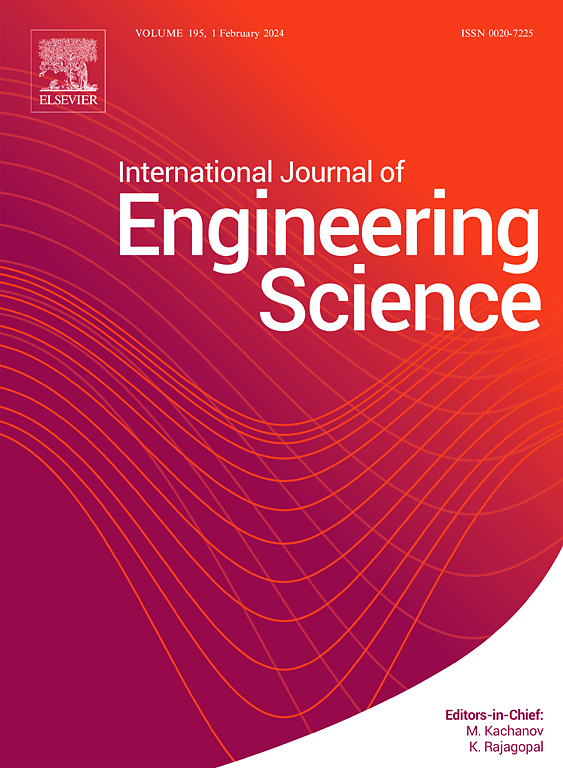动力学中的交叉介质
IF 5.7
1区 工程技术
Q1 ENGINEERING, MULTIDISCIPLINARY
International Journal of Engineering Science
Pub Date : 2025-08-20
DOI:10.1016/j.ijengsci.2025.104368
引用次数: 0
摘要
我们的目标是为嵌入时空m中的维数(d+1)的物质流形N所表示的维数d的物质体的动力学开发一种通用方法。它可以专门用于d=0(点状物体),d=1(如果它是固体,则为拱形,如果它是流体,则为管道或射流),d=2(如果它是固体,则为板或壳),d=3(笨重的物体)。我们称其为仿射实数函数在仿射切空间到时空的向量空间上的偏对称双线性映射。我们使用最初由Élie Cartan提出的仿射连接,也就是与仿射基团相关的连接。引入协变散度自由扭量的一般原理,推导出10个平衡方程。我们通过在伽利略相对性的背景下应用d从1到4来证明这个一般原理的相关性。本文章由计算机程序翻译,如有差异,请以英文原文为准。
Cosserat media in dynamics
Our aim is to develop a general approach for the dynamics of material bodies of dimension represented by a matter manifold of dimension embedded into the space–time . It can be specialized for (pointwise object), (arch if it is a solid, flow in a pipe or jet if it is a fluid), (plate or shell if it is a solid, sheet of fluid), (bulky bodies). We call torsor a skew-symmetric bilinear map on the vector space of affine real functions on the affine tangent space to the space–time. We use the affine connections as originally developed by Élie Cartan, that is the connections associated to the affine group. We introduce a general principle of covariant divergence free torsor from which we deduce 10 balance equations. We show the relevance of this general principle by applying it for from 1 to 4 in the context of the Galilean relativity.
求助全文
通过发布文献求助,成功后即可免费获取论文全文。
去求助
来源期刊

International Journal of Engineering Science
工程技术-工程:综合
CiteScore
11.80
自引率
16.70%
发文量
86
审稿时长
45 days
期刊介绍:
The International Journal of Engineering Science is not limited to a specific aspect of science and engineering but is instead devoted to a wide range of subfields in the engineering sciences. While it encourages a broad spectrum of contribution in the engineering sciences, its core interest lies in issues concerning material modeling and response. Articles of interdisciplinary nature are particularly welcome.
The primary goal of the new editors is to maintain high quality of publications. There will be a commitment to expediting the time taken for the publication of the papers. The articles that are sent for reviews will have names of the authors deleted with a view towards enhancing the objectivity and fairness of the review process.
Articles that are devoted to the purely mathematical aspects without a discussion of the physical implications of the results or the consideration of specific examples are discouraged. Articles concerning material science should not be limited merely to a description and recording of observations but should contain theoretical or quantitative discussion of the results.
 求助内容:
求助内容: 应助结果提醒方式:
应助结果提醒方式:


